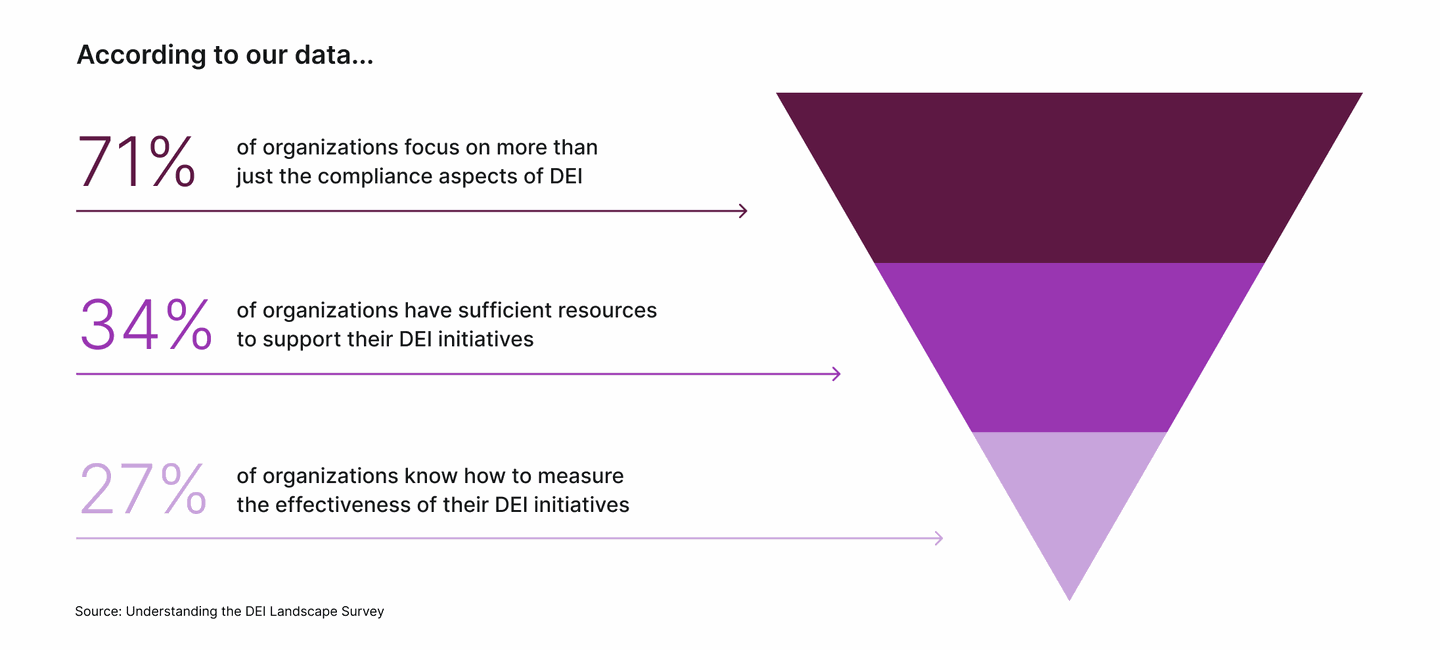Key takeaways
Learn about other ways to quantify your HR goals: Top 26 Metrics to Track
Top 11 DEI metrics and how to measure them
There are many DEI metrics, but it’s critical to consider which DEI metrics will offer the most insight for your organization.
For example, a large company might be interested in collecting detailed demographic data to understand which employee resource groups would be most popular. A startup company, on the other hand, might be more concerned with learning which job boards recruit the widest variety of candidates.
In addition, there are several ways to measure various DEI metrics. Some are purely quantitative or qualitative, but a mix of both methods is often necessary to paint an accurate picture.
The variety of measurement methods is nearly as important as the things being measured, but this can become overwhelming very quickly. Most workforce analytics platforms — especially ones that integrate with other HR tools — make it easier to interpret these intricate data sets in a centralized dashboard.
1. Workforce demographics
Workforce demographics capture employee characteristics like age, gender identity, race, ethnicity, sexuality, disability status, religious background, and education. HR teams and business leaders can use those data points to draw big-picture statistics about the makeup of their workforce across different demographic categories.
Demographic surveys are an effective way to measure the current makeup of your workforce, as long as you include a wide variety of identities. Ensuring anonymity in these surveys is also essential; employees are more likely to self-identify if they know they are doing so in confidence.
DEI tools for workforce demographics
Many HR software platforms have DEI-focused demographic tracking, including Lattice, Diversio, Qualtrics, and Workday.
2. Leadership demographics
As a subset of workplace demographics, leadership demographics measure the percentage of different identity groups among managers, senior leaders, and executive teams. If diversity dissipates as you move up the org chart, there are likely systemic or cultural barriers that are limiting diverse employees’ advancement opportunities.
For example, the 2023 Women in the Workplace report found that only 54 Black women are promoted to entry manager roles for every 100 men — a disparity that severely diminishes the opportunities Black women have to move further and further up the ladder.

Research also shows the tangible benefits of diversity among leaders: McKinsey’s 2020 report on the business impact of diversity found that companies in the top quartile of gender-diverse leadership teams were 25% more likely than the bottom quartile to have above-average profitability; for the top quartile of ethnic diversity, that number is 36%.
When measuring your organization’s overall advancement and promotion rate, a DEI lens may reveal performance review biases or inconsistencies that create problematic patterns. In many cases, detailed career paths and transparent job expectations are starting points for increasing demographic diversity up the ladder.
DEI tools for leadership demographics
People management software Lattice allows you to track and sort performance metrics and internal mobility by gender, age, race, and sexual orientation.
3. Recruitment and hiring
Building a diverse workforce begins with the hiring process. If your organization’s pool of applicants lacks diversity or if job offers typically go to candidates from similar backgrounds, it’s time to start paying attention to recruiting metrics. Layering demographic data with recruiting metrics like interview-to-hire ratio and offer acceptance rate can help your organization uncover challenges and concerns that might be getting in the way of DEI progress.
Demographic surveys attached to job applications can be used to gauge the diversity of your applicant pool, but they must be used cautiously. Communicate your intent clearly and assure the applicant that the survey is anonymous and has no bearing on the hiring process.
DEI tools for recruitment and hiring
Along with DEI reporting, hiring management software Applied comes equipped with bias reduction methods, including anonymized applications and a tool to remove gender-biased language in job descriptions.
Read more: Strategies for Cultivating a Diverse Talent Pool
4. Retention and turnover
Hiring people from a wide variety of backgrounds is important, but it’s just as important to make sure they stick around and feel supported during their tenure. Creating an environment of safety and cultural competence makes a big difference in retention rates for marginalized identities; in 2021, nearly half of Black and Hispanic workers reported leaving a job due to witnessing or experiencing workplace discrimination.
Exit interviews are a way to identify general problems that lead to employee attrition, but breaking down turnover rates by demographic will help your organization spot patterns and determine whether any particular identity group is being underserved. Once you understand the problem, you can direct attention toward better supporting that community.
DEI tools for retention and turnover
Workday’s augmented analytics tool uses machine learning to draw key insights from workforce data; your organization can use this tool to identify demographic patterns in attrition rates.
5. DEI events and groups
DEI events and groups take a number of forms. Dedicated employee resource groups for specific demographics can help build and advocate for those communities, and company-wide events and educational workshops aid in building allyship through the organization. Some specific examples of DEI events and groups include:
- Volunteer opportunities for Indigenous Peoples Day or Juneteenth.
- A Pride Month celebration led by LGTBQIA+ employees.
- An ERG where Hispanic and Latino employees discuss their experience in the workplace.
- A company-wide workshop on improving accessibility for disabled employees and customers.
Qualitative and quantitative feedback is necessary to measure the success of these events. Your organization should track metrics like attendance and participation, but you should also measure engagement through subjective feedback from participants. Asking them to identify the strengths and weaknesses of DEI programming will help you make future improvements.
Looking for programming ideas? Read: What Is DEI Training & How To Implement It
6. Pay equity
Pay rates should be analyzed at the role and department levels, but it’s also essential to consider different demographics, years of experience, and tenure in the role or with the company.
Compensation equity is a good metric to analyze alongside recruitment, retention, and development rates. Looking at these metrics together can help you identify groups of people who are not getting the same growth opportunities as others.
For example, NPR’s research found that even when controlling for as many variables as possible, women still earned 8% less on average compared to men working the same job. There are several potential reasons for this, including the fact that women tend to be judged more harshly for asking for more money, but NPR still refers to it as the “unexplained pay gap.”
DEI tools for pay equity
ADP’s compensation management software has tools to establish salary benchmarks and reduce bias during compensation reviews.
7. Resource allocation
Organizations with a sincere commitment to DEI must provide adequate financial and personnel resources to support their DEI goals. The DEI committee, HR department, leadership team, and finance department should work together to create a reasonable budget for DEI events, training, and other programming. Other resources, like office space and employees’ time during business hours, should be allocated for DEI initiatives when necessary.
8. Employee satisfaction
Employee satisfaction should be measured both quantitatively and qualitatively. For example, an employee taking a Net Promoter Score (eNPS) survey gives a quantitative rating of their satisfaction with the company and explains why they gave that score. The numeric data can be aggregated to determine an overall employee satisfaction score, while the individual responses can be grouped based on themes, employee tenure, demographic information, and other factors.
Ranked method metrics, where employees rate different statements such as “I feel supported by my manager” or “I have clear opportunities to grow with this company” on a scale of one to five can also be helpful. HR and business leaders can examine overall scores to determine which areas need the most improvement.
DEI tools for employee satisfaction
Diversio’s anonymized engagement surveys assess employee satisfaction across a variety of factors, including onboarding, career growth, and cultural competence, through a DEI-focused, intersectional lens.
9. Accessibility
The Americans with Disabilities Act (ADA) mandates physical accessibility standards for various areas of your workplace, including parking spaces, stairways, fire alarms, and restrooms. Additionally, the EEOC enforces protections against discrimination, harassment, privacy violations, and other injustices employees with disabilities may face in the workplace. These regulations are a good starting place, but there are ways to push those standards further to create a truly inclusive workplace.
Consider hiring an external consultant to check the accessibility of your office building. An accessibility specialist can provide recommendations to improve the floor plan, interior design choices, and environmental conditions that may inadvertently create extra challenges for employees with disabilities. For those working from home, closed captioning on video meetings can help those with auditory or cognitive impairments; Zoom has this as a built-in option.
For web properties, include regular audits as part of your key performance indicators (KPIs) to help ensure your content is accessible to all users. Tools like WAVE, Monsido, and accessiBe can help determine if font size, website colors, video, audio, and other website features are easy to use.
10. External demographics
Analyzing external graphics helps determine if you’re actually reaching the right audiences in the right way. Examples of external demographics you can measure include:
- Customer demographics and brand sentiment.
- Supplier demographics.
- Demographics of regions where the business operates compared to the demographics of the business itself.
Sorting customer reports by demographic can shed light on whether and how certain groups of people feel served by your organization, giving you an opportunity to adjust your strategies to better serve your DEI and market goals.
DEI tools for external demographics
Qualtrics’ customer segmentation tools allow you to organize your market into different demographics for a picture of client diversity and customize your communication for each group.
11. DEI initiative success
Once your organization has identified problems in its DEI strategies and set goals to improve them, DEI metrics will track the success of those initiatives.
For example, if you notice that men comprise the majority of your talent pool, update your job descriptions to eliminate gendered language and monitor your applicant demographic data to determine whether the change made an impact. In most cases, closing large DEI gaps requires multiple strategic efforts over time.
Measuring DEI initiative success will probably involve a combination of other metrics; if you’re tracking these metrics effectively, then you can determine an initiative’s success by identifying the desired changes in demographics, satisfaction, promotion rates, or whatever area you’re targeting, and tracking the changes from the program’s implementation. Qualitative feedback through surveys can also help gauge whether employees notice and appreciate the change.
DEI metric FAQs
Using your DEI metrics
For any DEI strategy to be effective, you need efficient and effective ways to identify DEI issues within the organization. DEI metrics provide a strong foundation for identifying those problems, as well as for tracking growth as you implement DEI initiatives.
Once you’ve perfected those measurements, the real work to move the needle begins.






